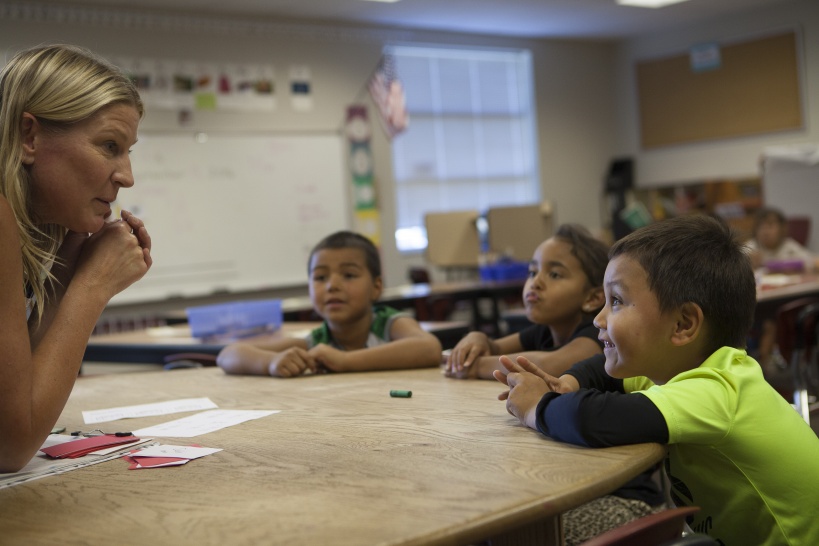You are viewing ARCHIVED content published online before January 20, 2025. Please note that this content is NOT UPDATED, and links may not work. Additionally, any previously issued diversity, equity, inclusion or gender-related guidance on this webpage should be considered rescinded.
Washington, D.C. – The Bureau of Indian Education (BIE) announced today the release of the BIE Strategic Direction (“Direction”) for 2018-2023. The Direction is designed to improve the ability of the BIE to increase its services to Native students by organizing management activities, setting priorities, and ensuring efficient and effective utilization of staff and resources. The Direction emphasizes the importance of fostering collaborative relationships between the BIE, tribes, school boards, employees and other stakeholders. The BIE recognizes the dynamically changing environment of Indian education and expects to continue developing the Direction in response to feedback and new ideas from stakeholders.
“This is a Strategic Direction plan that takes into account the expertise of parents, teachers, students, administrators, tribal leadership and Indian education advocates,” said Assistant Secretary – Indian Affairs Tara Sweeney. “I am grateful for the collective efforts given by those who dedicated their time and provided input into this project that supports tribal sovereignty which is a top priority for tribal communities and the Trump administration.”
“I applaud the efforts of the Bureau of Indian Education as they work to provide guidelines and a plan of action that will ultimately make sure we are able to provide students with the knowledge, skills and assistance needed to be successful in all facets of their education and in the future,” said Principal Deputy Assistant Secretary of the Interior for Indian Affairs John Tahsuda.
The BIE Strategic Direction brings the values of Excellence, Focus, Integrity, Respect and Service throughout the bureau to ensure students are provided a culturally relevant, high-quality education that prepares them with the knowledge and skills and behaviors needed to flourish in the opportunities of tomorrow. The Direction outlines six goals with strategies that will support and impact their successful implementation. These goals address the following:
- All students will enter kindergarten academically, socially and emotionally prepared to succeed in school;
- All students will develop the knowledge, skills, and behaviors necessary for physical, mental and emotional well-being in a positive, safe, and culturally relevant learning environment;
- All students will develop the knowledge, skills and behaviors necessary to progress successfully through school and be prepared for post-secondary education and/or career opportunities;
- All students will graduate high school ready to succeed in post-secondary study and careers, and to think globally;
- All students will develop the knowledge, skills and behaviors needed to lead their sovereign nations to a thriving future through self-determination; and
- All students will benefit from an education system that is effective, efficient, transparent and accountable.
“We are excited to see this collaborative work among our staff, educators, tribes and stakeholders flourish into an effective tool that will guide our future work,” said BIE Director Tony L. Dearman. “It is part of our ongoing commitment to offer the best to our students, their families and communities.”
“There is nothing more important to the future of tribal nations than providing our youth a quality education,” said Jefferson Keel, President of the National Congress of American Indians. “Ensuring that quality starts with having a vision and a plan. We are encouraged that the Bureau of Indian Education has taken this step to improve performance at schools that serve our students.”
“NIEA supports ongoing efforts to improve transparency and invest in excellent systems for data management and accountability through the new Bureau of Indian Education Strategic Direction,” said National Indian Education Association Executive Director Ahniwake Rose. “As implementation begins, we look forward to working with tribes, BIE officials and school leaders to expand opportunities for tribes to exercise sovereignty in Native education through tribal choice and access to data critical for student achievement.”
“We applaud the Bureau of Indian Education for the important work they did to engage and formally consult with a range of stakeholders throughout the development of their new strategic plan. Through this process, the BIE has built strong partnerships, including with Indian tribes across the country, that will ensure the success of this effort,” said Council of Chief State School Officers Executive Director Carissa Moffat Miller. “This plan establishes a roadmap for providing an equitable education for all BIE students, and we look forward to our continued collaboration with the Bureau through its implementation.”
The Bureau of Indian Education implements federal Indian education programs and funds 183 elementary and secondary day and boarding schools (of which two-thirds are tribally operated) located on 64 reservations in 23 states and peripheral dormitories serving over 48,000 students. BIE also operates two post-secondary schools, and administers grants for 30 tribally controlled colleges and universities and two tribal technical colleges, and provides funding for higher education scholarships to Native youth. For more information, visit the BIE website.
For Immediate Release: August 23, 2018


